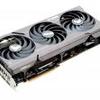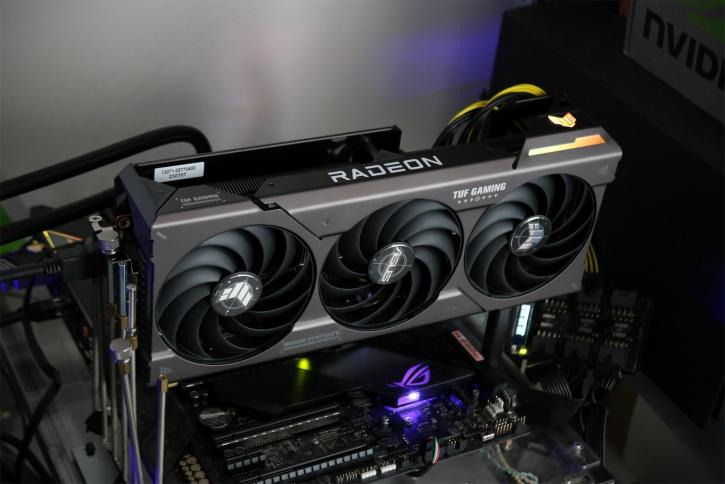Introduction
ASUS Radeon RX 7800 XT TUF Gaming OC review
ASUS has unveiled the TUF Radeon RX 7800 XT Gaming OC, distinguished by its refined design. Occupying nearly three slots, this component can marginally exceed the clock speed of the reference model. It is equipped with two 8-pin power inputs. A unique attribute is its secondary BIOS mode, offering a silent operation—making it the inaugural 7800 XT model to provide this noise-reduced option. The Radeon 7800 XT with its 16GB 256-bit memory configuration at 19.5 Gbps, is bound to impress. This particular iteration is poised to utilize the complete 60 CU / 3840 Shader processors setup of the GPU and boasts a Total Board Power (TBP) of 263W. The AMD Radeon RX 7800 XT GPU is built upon the Navi 32 SKU framework and thus chiplets, incorporating four Memory Controller Domains (MCDs). The GPU core boasts 3840 cores, meticulously distributed across 60 Compute Units to enhance performance. Additionally, the GPU incorporates a substantial 64 MB Infinity Cache, functioning at an 18 Gbps pin speed, yielding a commendable total bandwidth of 576 GB/s. The second Navi 32 variant, aka Radeon RX 7700 XT, sees a friendly 54 CU/3456 shader processor configuration, complemented by 12GB memory on a 192-bit bus running at an effective 18 Gbps data rate. This points towards a Navi 32 iteration with one of the four MCDs disabled, resulting in 48 MB of Infinity Cache. The core setup of the RX 7700 XT is anticipated to encompass approximately 54 Compute Units, housing a total of 3456 stream processors.
| AMD Radeon RX 7000 Specifications | |||||
|---|---|---|---|---|---|
| Radeon RX | 7900XTX | 7900 XT | 7800 XT | 7700 XT | 7600 |
| Architecture | RDNA3 (TSMC N5) | RDNA3 (TSMC N5) | RDNA3 (TSMC N6) | RDNA3 (TSMC N6) | RDNA3 (TSMC N6) |
| GPU | Navi 31 XTX | Navi 31 XT | Navi 32 XL | Navi 32 XT | Navi 33 |
| GPU Clusters | 96 CUs | 84 CUs | 60 CUs | 54 CUs | 32 CUs |
| FP32 Cores | 6144 | 5376 | 3840 | 3456 | 2048 |
| Game Clock | 2.3 GHz | 2.0 GHz | 2.124 GHz | 2.171 GHz | 2.25 GHz |
| Boost Clock | 2.5 GHz | 2.4 GHz | 2.43 GHz | 2.54 | 2.625 GHz |
| Memory | 24GB G6 | 20GB G6 | 16GB G6 | 12 GB G6 | 8GB G6 |
| Memory Bus | 384-bit | 320-bit | 256-bit | 192-bit | 128-bit |
| Memory Speed | 20 Gbps | 20 Gbps | 19.5 Gbps | 18 Gbps | 18 Gbps |
| L3 Cache | 96 MB | 80 MB | 64 MB Gen2 | 48MB Gen2 | 32 MB Gen2 |
| Board Power | 355W | 315W | 263W | 245W | 165W |
| Power Connectors | 2 × 8-pin | 2 × 8-pin | 2 × 8-pin | 2 × 8-pin | 1 x 8-pin |
| PCIe Interface | Gen4 x16 | Gen4 x16 | Gen4 x16 | Gen4 x16 | Gen4 x8 |
| MSRP | $999 | $899 | $499 | $449 | $269 |
| Launch Date | December 2022 | December 2022 | September 2023 | September 2023 | May 2023 |
ASUS has incorporated its robust cooler from the RTX 7900 TUF Gaming model into the design of this card. With dimensions spanning a width equivalent to three expansion slots and a length of 320mm, the card is sizable. Though seemingly extensive, given the RDNA 3 card's power specifications, ASUS justifies this design by promising users enhanced overclocking versatility and improved acoustics. AMD suggests a game clock of 2.4GHz for the RX 7800 XT, marking the expected operational speed during gaming. However, ASUS adjusts this default speed to 2.520 GHz, and further boosting it to 2565 MHz. While these enhancements appear incremental, they do contribute to overall performance. The TUF Gaming cards feature two 8-pin PCIe power ports. Emphasizing durability, the TUF Gaming insignia stands for superior component quality. This includes a reinforced die-cast frame which seamlessly integrates with the aluminium backplate and shroud, adding extra resilience. The revamped cooling system uses Axial-tech fans, increasing the airflow around the backplate's perimeter and expanding the cooling zone by 20%. An accessible switch on the card's Dual BIOS permits easy toggling between performance and quiet modes, or further adjustments can be made in the GPU Tweak III settings. By default, the card is set to performance mode, offering a performance uptick of 3%-4% over reference cards. The Radeon RX 7800 XT employs a standard 8-pin PCIe connector, avoiding the contentious 12VHPWR port, and will need three such connectors. For display options, it provides one HDMI 2.1 port along with three DisplayPort 2.1 ports. Let's delve deeper into the review.


